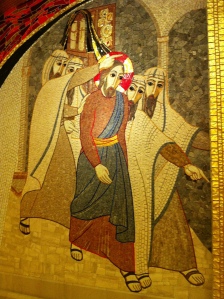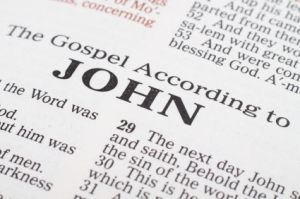In the seventeenth post regarding my recap/review of James Dunn’s newest volume Neither Jew nor Greek I will draw out a particularly fascinating discussion on how the Fourth Gospel contributed (and in what sense) to the ‘Parting of the Ways’ between Judaism and Christianity (section 46).
 Dunn outlines this chapter by first discussing how the terms ‘Judaism’ and ‘Christianity are unhelpful terms because they are not defined and distinguished entities during this period of inquiry. He moves on to note some of the early strains between the followers of Jesus and their Jewish counterparts, such as the death of the Messiah, the once-and-for-all sacrifice of Jesus, and the lynching of Stephen in Acts 7. Furthermore, Rome’s involvement certainly caused ripples between the two groups with the destruction of the temple (70 CE), the fiscus Judaicus, and the revolts in 115-117 and 132-135 CE. During this time Judaism was being refined with the slow emergence of Rabbinic Judaism and the fading away of other sects (Essenes, Sadducees, etc.). Four NT documents (Matthew, Acts, John, and Hebrews) are likewise examined to see in what sense do they depict the conflicts between Jews and early Christians. Finally, Dunn notes the writings of the second century Apologists, Church Fathers, and others to observe how the tone has changed during their time periods. This entire chapter is a gold mine of excellent historical data and should be required reading for Church History students (who rarely get exposed to the developments between the first and second centuries CE).
Dunn outlines this chapter by first discussing how the terms ‘Judaism’ and ‘Christianity are unhelpful terms because they are not defined and distinguished entities during this period of inquiry. He moves on to note some of the early strains between the followers of Jesus and their Jewish counterparts, such as the death of the Messiah, the once-and-for-all sacrifice of Jesus, and the lynching of Stephen in Acts 7. Furthermore, Rome’s involvement certainly caused ripples between the two groups with the destruction of the temple (70 CE), the fiscus Judaicus, and the revolts in 115-117 and 132-135 CE. During this time Judaism was being refined with the slow emergence of Rabbinic Judaism and the fading away of other sects (Essenes, Sadducees, etc.). Four NT documents (Matthew, Acts, John, and Hebrews) are likewise examined to see in what sense do they depict the conflicts between Jews and early Christians. Finally, Dunn notes the writings of the second century Apologists, Church Fathers, and others to observe how the tone has changed during their time periods. This entire chapter is a gold mine of excellent historical data and should be required reading for Church History students (who rarely get exposed to the developments between the first and second centuries CE).
I will now move to interacting with Dunn’s section on how the Gospel of John contributed to the ‘Parting of the Ways’ between what eventually came to be known as Judaism and Christianity. The section (46.5c) notes how the GJohn apparently goes out of its way to argue how traditional Jewish icons are now passé in light of the coming of Christ (temple to body, purification water into wine, Jacob’s well into living water, manna from heaven to bread of life, etc.). These themes seem to indicate that GJohn invites its readers (especially the Jews of its time) to see Jesus as the fulfillment of Israel’s hopes and visions.
It is in GJohn that ‘the Jews’ are the designated antagonists, regularly hostile to Jesus. In John 8:39-44 Jesus defines them as “children of the devil” rather than children of Abraham. This sharply distinguishes ‘the Jews’ from Jesus and his followers (who are also Jewish). It seems, after a closer examination, that ‘the Jews’ most likely refers to the Jewish authorities, in contrast to even the neutral crowds and common folk observing the dialogues of Jesus and his opponents.
 Of particular interest is the phrase coined by GJohn aposynagogos, “expelled from the synagogue.” In John 9:22 the parents of the blind man refuse to stand up for their own son in fear of ‘the Jews’ who threatened to put out of the synagogue anyone who confessed Jesus as Messiah. The next reference is in 12:42 where many of the rulers believed in Jesus, but did not publicly confess him for fear of the Pharisees, lest they be put out of the synagogue. The third and final reference is in 16:2 where Jesus warns that his disciples should expect to be kicked out of the synagogue. It has been common in Gospel of John scholarship to suggest that the blessing against the heretics (known as the birat ha-minim) had already been pronounced by the post-70 rabbinical authorities and that this pronouncement in synagogues explains the social situation exhibited in John 9:22; 12:42; and 16:2. Dunn argues that this suggestion is problematic and unable to be sustained historically principally because the reference to the Christians within this blessing was likely a later addition. Dunn concludes, nevertheless, that the three references to synagogue-expulsion indicate that the pressures towards the parting of the ways was instigated on the side of Judaism rather than Christians.
Of particular interest is the phrase coined by GJohn aposynagogos, “expelled from the synagogue.” In John 9:22 the parents of the blind man refuse to stand up for their own son in fear of ‘the Jews’ who threatened to put out of the synagogue anyone who confessed Jesus as Messiah. The next reference is in 12:42 where many of the rulers believed in Jesus, but did not publicly confess him for fear of the Pharisees, lest they be put out of the synagogue. The third and final reference is in 16:2 where Jesus warns that his disciples should expect to be kicked out of the synagogue. It has been common in Gospel of John scholarship to suggest that the blessing against the heretics (known as the birat ha-minim) had already been pronounced by the post-70 rabbinical authorities and that this pronouncement in synagogues explains the social situation exhibited in John 9:22; 12:42; and 16:2. Dunn argues that this suggestion is problematic and unable to be sustained historically principally because the reference to the Christians within this blessing was likely a later addition. Dunn concludes, nevertheless, that the three references to synagogue-expulsion indicate that the pressures towards the parting of the ways was instigated on the side of Judaism rather than Christians.
The other relevant feature in GJohn is the objection on the side of Judaism that claims being made of Jesus by his followers were a threat to God’s unity. Dunn cites John 5:18 (‘the Jews’ seek to kill Jesus because he was calling God his own Father, thereby making himself equal to God) and 10:30-31 (‘the Jews’ pick up stones to stone Jesus in response to the statement, “I and the Father are one”). In the Synoptic Gospels there appears to be no fierce reaction from the Jewish authorities quite like John 5:18 and 10:31. Dunn notes that the question of why these claims about Jesus were not made prior to the year 70 CE has not been sufficiently asked. The solution seems to be that John’s understanding of Jesus is best explained through the lens of God sending an authorized agent who bears the name and privileges of God himself. Or, in the words of Dunn,
…much of John’s christology can be best seen in the context of late Second Temple Jewish reflection on divine epiphanies and divine agency.
Dunn goes on to note some of the particular christological points in GJohn. Of interest are these bullet points:
- The Wisdom/Logos christology of John 1:1-18 is essentially a part of the Wisdom theology of Lady Wisdom traditions exhibited in Prov. 8; Sirach 24; and Baruch 3-4. Philo’s Logos theology is also influential;
- John 3:13 seems to be a direct rebuttal of other Jewish claims to heavenly journeys and apocalyptic visions (only Jesus is the designated revealer of God);
- The Son of Man ascending/descending in 3:13 and 6:62 is an extension of reflection on Dan. 7:13-14, a reflection in which 1 Enoch and 4 Ezra also were taking part;
- The motif of Jesus as the one whom God “sent” sounds like the theme of God sending a prophet, but transcends both the prophet and the kingly figures;
- The “I am” statements and other claims like John 8:58 “would not ring oddly to anyone familiar with the ‘I’ claims of Wisdom.”
John’s christology was not foreign to the Judaism of the period, argues Dunn. It seems that it was the claim that Jesus was God’s authorized agent, likened to God’s Wisdom, which was the factor provoking the post-70 CE rabbis to regard these Christ-followers as heretics (the minim). Dunn notes that the Gospel of John did not finalize this split, pointing to the second-century christological controversies which continued to bring definition to Christianity and Judaism which were both attempting to define each other over and against the other.
In sum, the Gospel of John indicates that the rabbis expelling Christians from the synagogue in a disagreement as to whether Jesus really was God’s authorized and empowered Messiah, and that the Johannine community indicates that this schism was well under way at the end of the first century CE.
What do you think of Dunn’s reconstruction? Be sure to ‘like,’ share, and subscribe for further updates!



